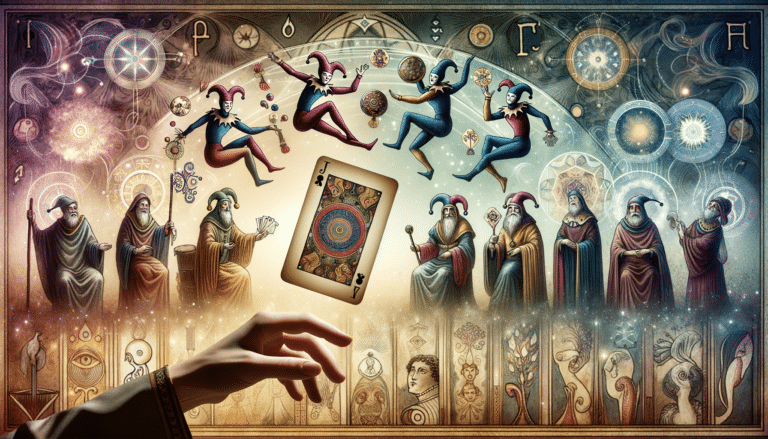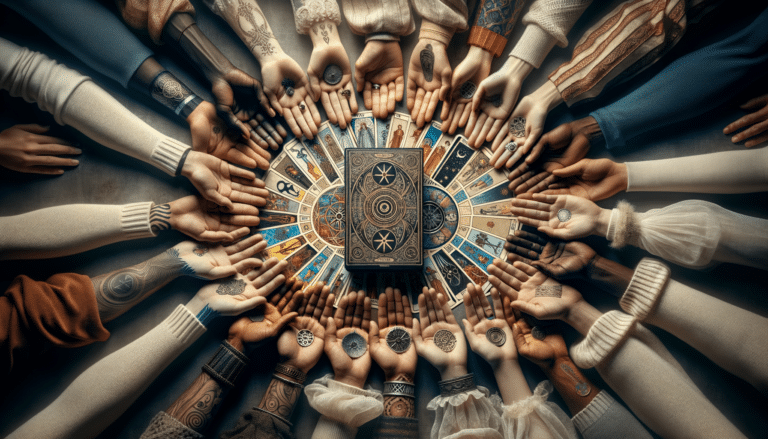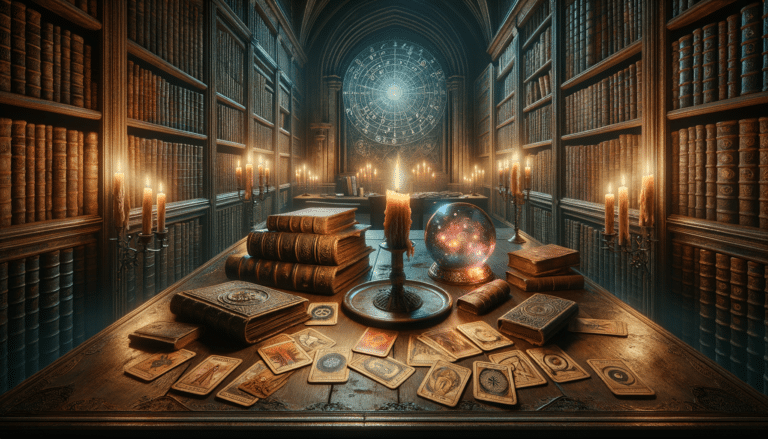Top 4 Insights into Tarot Card History in Italy
Picture yourself meandering through the vibrant streets of Renaissance Italy, where the rich tapestry of culture weaves together art, philosophy, and the mystique of tarot cards.
You’re about to uncover the layers of tarot card history in Italy, a journey that’ll lead you to the origins of the enigmatic tarocchi.
You’ll explore the famed Visconti-Sforza deck, marvel at the intricate symbolism that reflects Renaissance thought, and witness how these cards transitioned from game pieces to tools of divination.
As you delve into these four compelling insights, you’ll gain a deeper appreciation for the tarot’s place in Italian heritage and its enduring legacy in the mystical arts.
Key Takeaways
- Tarocchi originated in mid-15th century during the Italian Renaissance and were initially used for playing games, not divination.
- The Visconti-Sforza Deck, one of the oldest surviving tarot decks from the 15th century, offers insight into the social and political life of Renaissance Italy.
- Renaissance art and thought deeply influenced tarot cards, with each card reflecting the period’s ideals.
- Tarot cards transitioned from games to divinatory tools, with societal changes and evolving card printing techniques playing a role.
Origins of Italian Tarocchi

Delving into the history of Italy’s tarot cards, you’ll discover that the origins of ‘Tarocchi’ date back to the mid-15th century, amid the cultural flourish of the Italian Renaissance. It’s a journey into the arcane beginnings where art, mysticism, and society intersect.
You’d be intrigued to know that these cards were initially intended for playing games, quite different from the divinatory tools you might associate with them today.
The Mamluk influence on these cards is undeniable. Tarot’s ancestors likely stem from the Islamic Mamluk card game, brought over through trade routes. The Mamluks, ruling Egypt and the Mediterranean at the time, had a tradition of playing card games, and it’s believed that their intricate designs and courtly figures inspired the early Italian tarocchi decks.
As you’re piecing together this historical puzzle, you’ll appreciate the subtle blend of cultures and ideas that shaped the tarot. Their transformation from game cards to mystical symbols didn’t happen overnight. It was a gradual evolution influenced by the people’s love for symbolism, storytelling, and the search for deeper meaning.
The tarocchi’s journey from the Renaissance era to your hands is a tapestry woven with threads of history and human curiosity.
The Visconti-Sforza Deck

From the broader tapestry of tarot’s past, you’ll now encounter the Visconti-Sforza deck, a pivotal milestone in tarot history. This exquisite set of cards, born in the 15th century, is one of the oldest surviving tarot decks and indeed a crown jewel among noble collections. The Visconti-Sforza deck was commissioned by the Visconti family, who, along with the Sforza dynasty, ruled Milan and left a deep imprint on Italy’s cultural heritage.
As you delve into its card artistry, you’ll notice that the deck is replete with emblematic illustrations that reflect the sophistication of the time. Each card is a masterpiece, blending religious symbolism, medieval iconography, and aristocratic opulence. Interestingly, this deck wasn’t initially used for divination but was likely a parlor game for the nobility, a testament to its origins in courtly entertainment rather than mystical practice.
The Visconti-Sforza tarot cards aren’t just pieces of art; they’re historical artifacts that offer a window into the social and political life of Renaissance Italy. Their durability through the ages has allowed you to appreciate the evolution of tarot and its integration into the tapestry of cultural expression.
Check out our Tarot Decks here…
Renaissance Influence and Symbolism

While you explore the rich tapestry of tarot, it’s clear that Renaissance art and thought deeply imbued the cards with layered meanings and intricate symbolism. The era’s fascination with mystical art and cultural integration shaped the tarot, making it a mirror reflecting the complexities of human existence.
The cards are more than just pretty pictures; they’re a synthesis of the philosophical, religious, and artistic ideals of the time. You’ll find that the symbolism in each card is a deliberate choice that speaks to the collective consciousness of the period.
To make this more relatable, here’s a quick look at how Renaissance ideals are depicted in tarot symbolism:
| Card | Symbolism |
|---|---|
| The Magician | Represents human potential, with Renaissance-inspired tools that symbolize different elements and faculties. |
| The High Priestess | Embodies wisdom and hidden knowledge, echoing the period’s reverence for the mystical and the secretive. |
| The Chariot | Showcases triumph and will, reflecting the era’s celebration of human achievement and exploration. |
As you delve into the cards, you’ll discover a world where cultural integration and the quest for knowledge are paramount. The tarot isn’t just a set of images; it’s a journey through the rich landscape of Renaissance thought and its enduring legacy.
Learn more with these best tarot books here…
Transition to Divination Practices

You’ll see that the transition from game to divinatory tool marks a pivotal chapter in the history of Italy’s tarot cards. Originally intended for play, these intricately designed cards began to hold a deeper significance as methods of divination emerged. This wasn’t an overnight shift but a gradual adoption influenced by societal changes and evolving card printing techniques.
The art of printing cards evolved, and with it, so did the accessibility of tarot. What was once a luxury became more common, allowing tarot to spread beyond the aristocracy. As you dive deeper, you’ll find that an occultist revival in the 18th and 19th centuries played a crucial role in cementing tarot’s association with mysticism and the arcane.
This period saw figures like Antoine Court de Gébelin assert that tarot had ancient Egyptian origins, a claim that spurred interest and gave the cards a veneer of ancient wisdom. This narrative, though historically unsubstantiated, was compelling. It prompted a re-examination of the symbolism within the tarot, with practitioners linking the imagery to kabbalistic, alchemical, and astrological concepts.
Thus, tarot’s metamorphosis into a tool of divination was complete, and it became an essential part of Italy’s – and the world’s – esoteric tradition.
Learn even more secrets of the history of tarot here…
Conclusion
Now you’ve glimpsed the rich tapestry of Italy’s tarot heritage, from the enigmatic beginnings of Tarocchi to the opulent Visconti-Sforza cards. You’ve felt the pulse of the Renaissance in every symbol, every figure.
Yet, as the cards transitioned to tools of foresight, one can’t help but wonder: what secrets do they hold for you? Dare to draw your card, and the answers from Italy’s mystic past might just shape your future.

About The Author – Allen Hill
Allen Hill, the force behind Unknown Truth Tarot, has a YouTube following 6-times bigger than the population of his hometown, Miamisburg, Ohio. From his spiritually rich blog on Tarot and crystals to his role as CEO of The Unknown Truth Tarot Metaphysical Shop, Allen’s passion for the metaphysical shines through.
A master Tarot reader and “crystal junkie,” Allen is also a devoted dad to Dylan, 10, and Destiny, 24. When he’s not immersed in the world of Tarot and crystals, he enjoys poker and video gaming sessions, often humorously outplayed by Dylan.
Follow Allen on Twitter, Instagram, Facebook, TikTok, and subscribe to his Unknown Truth Tarot YouTube channel to join him on a journey of spiritual growth and self-discovery.








